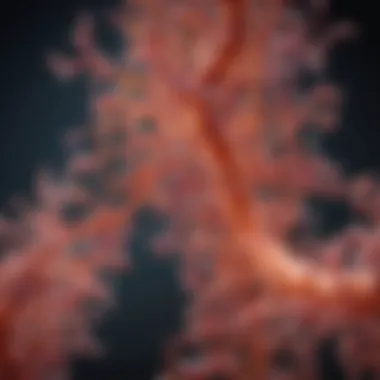Exploring Biochemical Tests for Escherichia coli


Intro
In the realm of microbiology, Escherichia coli stands out as a vital organism for both research and clinical diagnostics. The varied enzymatic profile of E. coli enables its identification through biochemical tests. This article dissects these methods and their implications in understanding the biochemistry underlying E. coli, a significant player in both health and disease.
Research Overview
Summary of Key Findings
Biochemical tests for E. coli have evolved over the years, leading to solid methodologies that researchers utilize today. Key findings highlight:
- The diversity of biochemical pathways that characterize E. coli.
- The effectiveness of various traditional biochemical tests, such as indole, methyl red, Voges-Proskauer, and citrate tests.
- The emergence of molecular techniques that supplement biochemical methods, such as PCR and next-generation sequencing.
These findings emphasize how understanding E. coli can inform both clinical treatment and food safety practices.
Relevance to Current Scientific Discussions
The significance of these biochemical tests transcends laboratory walls and reaches public health policies. Ongoing discussions in the scientific community focus on:
- The role of E. coli in gastrointestinal diseases.
- The implications of antibiotic resistance patterns observed in E. coli strains.
- Innovations in rapid diagnostic methods, which are crucial for timely intervention.
Understanding these nuances contributes to broader scientific dialogues regarding pathogen management and epidemiology.
Methodology
Research Design and Approach
To encapsulate the complexity of biochemical testing for E. coli, a systematic research design is employed. This includes a review of both historical and contemporary testing methods:
- Literature reviews on established tests.
- Case studies showcasing the application of these methods in clinical settings.
- Comparative analysis between traditional and emerging methods.
Data Collection and Analysis Techniques
Data are collected through primary literature and experimental studies. Key techniques include:
- Analysis of biochemical tests to determine metabolic profiles of various E. coli strains.
- Statistical methods for evaluating the sensitivity and specificity of these tests.
- Observational studies on test outcomes in clinical environments to gauge their effectiveness.
By structuring the methodology around these components, we aim to present a robust understanding of how biochemical tests for E. coli operate within scientific and clinical frameworks.
Intro to Escherichia coli
Escherichia coli, commonly known as E. coli, is a bacterium that resides in the intestines of humans and animals. It has become an important subject of study in microbiology due to its diverse roles, ranging from being a normal part of gut flora to its potential as a pathogen. In this article, we explore the necessary biochemical tests for identifying and understanding E. coli, highlighting its relevance in both clinical and research settings. The biochemical testing of E. coli serves multiple purposes, including the identification of pathogenic strains and the assessment of their metabolic capabilities. This foundational knowledge sets the groundwork for more advanced discussions regarding methods, implications, and limitations of detection.
Overview of E. coli
E. coli is a gram-negative, rod-shaped bacterium. It is classified within the family Enterobacteriaceae and is mostly non-pathogenic. However, some strains, such as E. coli O157:H7, cause serious foodborne illness. These pathogenic strains can lead to severe health conditions, emphasizing the need for accurate identification through biochemical tests. Many E. coli strains are well-studied and can ferment lactose, which aids in their identification. These characteristics enable researchers and practitioners to use specific biochemical tests to differentiate between non-pathogenic and pathogenic strains.
Significance in Microbiology
The importance of E. coli cannot be overstated in the field of microbiology. It is often used as a model organism for studying gene expression, mutation, and many metabolic processes. Furthermore, E. coli plays a crucial role in understanding microbial ecology and the relationship between gut health and disease. Its presence in environmental samples, such as water or soil, can indicate fecal contamination, which makes it a key indicator organism in public health. The implications of studying E. coli extend beyond microbiology into areas like epidemiology and food safety. Responses to outbreaks and effective testing protocols are heavily dependent on the accurate identification of E. coli strains.
Importance of Biochemical Testing
Biochemical testing plays a pivotal role in the microbiological landscape. It enhances our understanding of Escherichia coli, a significant organism in both health and disease contexts. By employing various biochemical tests, researchers and health professionals can identify specific strains of E. coli, assess their pathogenic potential, and draw meaningful insights about their behavior in different environments.
One of the key elements of biochemical testing is its ability to provide rapid and reliable identification of microbial species. This is crucial in clinical settings where timely diagnosis can influence treatment decisions. Identifying the presence of pathogenic E. coli strains promptly allows for appropriate interventions, with implications for patient outcomes and public health strategies.
The benefits of biochemical testing extend beyond identification. Understanding the metabolic pathways of E. coli enables microbiologists to predict the organism's behavior and its interaction with host systems. For instance, tests that assess enzymatic activity or substrate utilization can give clues about possible virulence traits. In this way, biochemical assays contribute to a more nuanced understanding of the organism's role in infections.


Several considerations are vital when discussing the importance of biochemical testing. First, the tests must be chosen wisely to match the specific characteristics of the microbial strains being studied. Not every test is suitable for every strain; therefore, understanding the unique attributes of the strain in question is paramount. Additionally, the accuracy of these tests is influenced by environmental factors, such as temperature or the presence of competing microbial flora.
In summary, biochemical testing is an indispensable tool in microbiology. It not only aids in identifying E. coli species but also equips researchers and healthcare providers with the information needed to address potential public health risks and develop effective treatment protocols. As our understanding of microbial biology expands, so too will the relevance of these biochemical methods in various applications.
Common Biochemical Tests
Biochemical tests play a crucial role in the identification and characterization of Escherichia coli. These tests are essential for distinguishing E. coli from other microorganisms, as they utilize specific metabolic characteristics unique to this bacterium. Being able to accurately identify E. coli has significant implications not only in clinical microbiology but also in environmental and food safety areas.
The primary benefits of utilizing biochemical tests include quick turnaround times, low costs, and the ability to use standard laboratory equipment. Moreover, biochemical tests may serve as a preliminary step before more advanced molecular methods. However, it is crucial to understand the limitations and potential for misidentification or oversights of these tests.
Given the diversity within the E. coli species, the choice and interpretation of these biochemical tests is key. Properly implemented, they contribute to accurate diagnostics, epidemiological studies, and ultimately, public health. The following sections discuss five common biochemical tests used to identify and analyze E. coli, highlighting their methodologies, implications, and limitations.
Lactose Fermentation Test
The Lactose Fermentation Test assesses the ability of E. coli to ferment lactose into acid and gas. This process occurs in specific culture media, such as MacConkey agar, which contains lactose and a pH indicator. Positive tests are indicated by a color change or gas bubble in the Durham tube. This characteristic is significant, as a large number of pathogenic E. coli strains are lactose fermenters, which allows for differentiation from non-fermenters like Salmonella. However, false negatives can occur with strains that may not readily ferment lactose due to adaptation or growth conditions.
Indole Production Test
The Indole Production Test measures the ability of E. coli to convert tryptophan into indole. In this test, a culture is treated with Kovac's reagent. A positive result is indicated by a red ring forming on top of the culture medium. This test is particularly useful because E. coli is one of the few lactose fermenting bacteria that produces indole. Hence, it assists in confirmation of identification, particularly among other lactose fermenters. Nevertheless, not all E. coli strains produce indole, pointing to another potential limitation for broad reliance on this test alone.
Methyl Red Test
The Methyl Red Test determines the acidity of the fermentation products. E. coli is a mixed acid fermenter, and in this test, after incubation, methyl red indicator is added. A positive result is marked by a red color change, indicating a low pH. This test is critical in situating E. coli in the broader context of Enterobacteriaceae. It is straightforward and provides clear results. However, some other species can yield false positives; thus, it should be interpreted with caution when used in conjunction with other tests.
Voges-Proskauer Test
In contrast, the Voges-Proskauer Test checks for the production of acetoin, a byproduct of glucose fermentation. After incubation, the addition of α-naphthol and potassium hydroxide will indicate a positive reaction through the formation of a red color. This test is significant for distinguishing E. coli from other species that may also ferment glucose but produce different fermentation products. As with other tests, there is a risk for false negatives, as some strains, particularly of E. coli, may not produce acetoin under certain conditions.
Citrate Utilization Test
The Citrate Utilization Test evaluates whether E. coli can utilize citrate as its sole carbon source. This test is conducted using Simmons Citrate agar, which contains bromothymol blue as a pH indicator. A positive result occurs when the medium turns blue, suggesting alkalinization due to citrate utilization. While this test helps differentiate E. coli from other species which cannot utilize citrate, not all E. coli strains exhibit this capability, thereby limiting its application in certain contexts.
These biochemical tests provide critical initial insights in the identification of E. coli. Understanding their mechanisms and limitations is vital for microbiologists in both clinical and environmental domains. By mastering these biochemical tests, professionals can better navigate their implications in health and safety.
Mechanisms of Action
The mechanisms of action for biochemical tests utilized in the identification of Escherichia coli are critical for understanding how these microbes interact with their environment and how they can be detected. By analyzing these mechanisms, researchers gain insight into the specific biochemical pathways that E. coli employs. This knowledge is essential for developing diagnostic tools which are both effective and robust.
Fermentation Pathways
Fermentation pathways are a central aspect of E. coli's metabolism. They allow this organism to break down various substrates in anaerobic conditions. This is particularly relevant for tests such as the lactose fermentation test, where the ability to ferment lactose produces acid and gas, indicating the presence of E. coli. During fermentation, E. coli converts carbohydrates into organic acids, gases, or alcohol, primarily through pathways like glycolysis. This process is not only crucial for growth but also for survival in nutrient-limited environments.
Here are some key characteristics of fermentation pathways in E. coli:
- Substrates Used: Various sugars, including glucose and lactose, are primary sources of energy.
- End Products: Fermentation typically results in the formation of lactic acid, acetic acid, and gases.
- pH Changes: The production of acids during fermentation often results in a drop in pH, which can be measured and indicates E. coli presence.
Metabolic Products
The metabolic products of E. coli's fermentation pathways have significant implications for biochemical testing. These products not only reflect the metabolic state of the bacteria but also aid in differentiating E. coli strains. For instance, indole production, a result of tryptophan metabolism, serves as a distinguishing feature for E. coli among other enteric bacteria. Understanding these products provides deeper insights into the metabolic capabilities and ecological niches of E. coli.
Some noteworthy metabolic products include:
- Indole: Indicates the capability to degrade tryptophan. Found in certain pathogenic strains.
- Acids: Various organic acids, leading to lower pH, indicative of carbohydrate fermentation.
- Gas Production: Gas bubbles in certain media confirm anaerobic metabolic activity.
By elucidating these mechanisms of action, we can enhance diagnostic accuracy and ensure timely identification of E. coli in various settings, from clinical laboratories to food safety testing.
Limitations of Biochemical Tests
Biochemical tests are vital for identifying strains of Escherichia coli in various contexts. However, these tests are not infallible. Understanding the limitations of biochemical testing is crucial for accurate interpretation of results. In clinical settings, false positives and negatives can have significant consequences, affecting diagnosis and treatment plans. Additionally, environmental influences can alter test outcomes, leading to unreliable data.


These limitations highlight the need for caution. Professionals must be aware of them to make informed decisions based on test results. Ultimately, acknowledging these shortcomings allows for better integration of biochemical tests with molecular identification methods, which can provide clearer insights into E. coli strains.
False Positives and Negatives
False positives and negatives are serious issues in biochemical testing for E. coli. A false positive occurs when the test indicates the presence of E. coli, but the organism is not present. This can lead to unnecessary treatments or interventions. On the other hand, a false negative may indicate no E. coli is present when it actually is. This can delay proper treatment, resulting in serious health consequences, especially in vulnerable populations.
Some reasons for these kinds of errors include:
- Cross-reactivity: Certain tests may react with similar organisms, leading to incorrect identification.
- Insufficient growth conditions: Improper media or temperature can hinder growth and result in false negatives.
- Human error: Misinterpretation of results by personnel can contribute to inaccuracies.
The implications of these errors demand diligence from laboratory technicians and clinicians. A strategy to mitigate these risks involves confirming biochemical test results with molecular methods, which can provide enhanced specificity and sensitivity.
Environmental Influences
Environmental factors can considerably affect the accuracy of biochemical testing for E. coli. For instance, variations in temperature, pH, and nutrient availability can impact the metabolic behavior of E. coli strains, possibly skewing results. Such influences may lead to unreliable observations, which enforce the notion that contextual factors must be considered during testing.
Further considerations include:
- Contamination of samples: External organisms contaminating samples can alter test results, leading to misleading conclusions.
- Storage conditions: How samples are stored can impact the viability of E. coli, affecting test outcomes.
- Environmental stressors: Factors like prgressingly high levels of salt or changes in oxygen availability can modify E. coli’s biochemical responses.
These environmental influences necessitate a careful approach when interpreting biochemical test results. By accounting for these conditions, researchers and clinicians can improve the reliability of their findings and ultimately enhance patient outcomes.
In summary, while biochemical tests for E. coli are invaluable, they are limited by potential inaccuracies in results. Recognizing these limitations fosters a more robust approach to microbial identification and enhances treatment efficacy.
Emerging Technologies in Detection
Advancements in the detection of Escherichia coli have been rapid and transformative. The significance of emerging technologies lies in their ability to enhance the accuracy and efficiency of biochemical testing. Traditional methods often fall short in resolving complex identifications and differentiating between pathogenic and non-pathogenic strains. Therefore, it is crucial to explore new methodologies that can offer improved resolution and specificity.
One of the most notable benefits of these technologies is their potential to deliver quicker results, which is vital in clinical settings. Speed in diagnosing infections can lead to timely intervention, which in turn, can save lives and enhance patient outcomes. Furthermore, emerging technologies can often be more sensitive, increasing the probability of identifying pathogens that may go undetected through conventional means.
Considerations about integrating new methods include training requirements for staff and the cost associated with implementing new technologies. It is imperative for institutions to weigh these factors against the potential benefits.
Molecular Techniques
Molecular techniques represent a leap forward in the detection and characterization of E. coli. These methods primarily involve the use of polymerase chain reaction (PCR) technologies.
Using PCR, specific DNA sequences can be amplified, allowing for the rapid detection of E. coli and its virulence factors. This method is particularly important when dealing with antibiotic-resistant strains, as it allows for the identification of resistance genes quickly.
Moreover, multiplex PCR enables detection of multiple pathogens in a single test, enhancing efficiency in outbreak investigations. As a result, healthcare professionals can respond effectively during public health crises.
The real-time PCR applications also permit quantification of bacterial load in a sample, allowing for a better understanding of the infection’s severity. While molecular techniques are revolutionary, they can also introduce challenges such as the requirement for specific reagents and sophisticated equipment.
Next-Generation Sequencing
Next-generation sequencing (NGS) is another remarkable technology that is reshaping how we approach E. coli detection. NGS offers the benefit of comprehensive genomic analysis, permitting extensive exploration of bacterial strains. This technology not only helps in identifying pathogens but also in understanding their genetic makeup and resistance profiles.
With NGS, researchers can examine single nucleotide polymorphisms and whole-genome sequences, providing insights into evolutionary trends and epidemiology. This thorough understanding can guide public health responses more effectively during outbreaks.
Additionally, the cost of sequencing has significantly decreased over the years, making it more accessible for laboratories worldwide. However, data analysis remains a complex hurdle, necessitating skilled professionals to interpret the massive amounts of data generated.
"Emerging technologies are key to the future of microbial detection, presenting new opportunities to address challenges in public health and food safety."
In summary, the integration of molecular techniques and next-generation sequencing into biochemical tests for E. coli holds tremendous potential. As these technologies continue to evolve, they promise to enhance detection methods, improve patient care, and better equip healthcare systems against the challenges posed by microbial pathogens.
Case Studies and Research Findings
The examination of case studies and research findings is crucial for understanding the implications of biochemical testing for Escherichia coli. Such studies offer insights into the complexities of E. coli pathogenicity and the effectiveness of various testing methods. They also highlight how biochemical tests can influence public health, epidemiology, and clinical treatment decisions. By analyzing documented cases, researchers can identify patterns that elucidate the behavior of E. coli in various environments and its response to different biochemical tests.


Recent Studies on E. coli Pathogenicity
Recent research has focused on the pathogenic strains of E. coli, such as Enterohemorrhagic E. coli (EHEC) and Enterotoxigenic E. coli (ETEC). These studies reveal significant information about how different biochemical tests correlate with the pathogenic potential of specific E. coli strains. For instance, investigations have shown that E. coli isolates from foodborne outbreaks often exhibit distinct biochemical profiles associated with virulence.
One study utilized the indole production test to differentiate between pathogenic and non-pathogenic strains. The results indicated that specific biochemical characteristics can serve as preliminary indicators of a strain's pathogenicity, influencing both public health responses and food safety protocols.
Moreover, continuous monitoring of E. coli in various environments, such as water sources and food production facilities, has underscored the importance of biochemical testing in identifying pathogenic strains early.
Biochemical Testing in Outbreak Scenarios
The role of biochemical testing in outbreak scenarios cannot be overstated. Quick and effective identification of pathogenic E. coli is essential for controlling outbreaks and preventing further transmission. Case studies often demonstrate how rapid biochemical tests can provide timely results that inform public health actions.
For example, during an outbreak linked to contaminated produce, rapid biochemical tests allowed for the identification of E. coli strains within hours. This expedited response helped health authorities trace the source and take preventive measures, reducing the incidence rate significantly. The use of the lactose fermentation test, for instance, has been instrumental in identifying E. coli in food safety assessments.
"Rapid identification of pathogenic strains during an outbreak can save lives and resources by enabling quicker public health interventions."
In summary, case studies and research findings about E. coli underscore the importance of biochemical tests not only in pinpointing virulence factors but also in orchestrating swift outbreak response strategies. Understanding these elements is vital for students, researchers, and professionals engaged in microbiology and public health.
Practical Applications of Biochemical Testing
Biochemical testing plays a crucial role in the identification and analysis of Escherichia coli. Its practical applications extend beyond laboratory settings, significantly impacting public health and food safety. Understanding these applications is essential as they facilitate the detection of pathogenic strains, enhance disease prevention strategies, and ensure the safety of food products.
Public Health Implications
The relevance of biochemical testing in public health cannot be overstated. E. coli is associated with various health issues, including severe gastroenteritis and urinary tract infections. Fast and accurate identification of pathogenic strains is necessary to contain outbreaks and prevent further spread of infections.
Efficient testing methods allow for rapid response mechanisms in healthcare systems. For example, testing populations after reported E. coli outbreaks helps trace the source of infection. This can inform necessary actions such as quarantine measures and vaccination protocols targeting at-risk groups.
Moreover, biochemical tests help in monitoring antibiotic resistance patterns among E. coli strains, where knowledge of resistance guides appropriate treatment strategies. This informs healthcare practitioners about the most effective antibiotics for treatment, promoting better outcomes for infected patients.
Effective biochemical testing not only mitigates current E. coli outbreaks but also prepares public health systems for future challenges.
Food Safety Testing
Foodborne illnesses caused by E. coli present significant risks to consumers, prompting rigorous food safety testing. Biochemical methods are essential in food safety protocols to detect contamination by pathogenic strains. These tests can efficiently assess raw materials and finished products, ensuring they meet safety standards.
For example, testing for E. coli in ground beef or fresh produce is a preventative measure implemented by numerous food manufacturers. This testing is crucial for identifying contaminated products early in the process, reducing the risk of large-scale recalls and safeguarding consumer health.
Additionally, regular testing in food processing facilities establishes a consistent monitoring system. This practice ensures compliance with regulatory standards and good hygiene practices.
With emerging technologies, the speed and accuracy of food safety testing only increase. Advanced techniques, such as polymerase chain reaction (PCR) assays, allow for rapid detection of E. coli, making it possible to ensure food safety without causing significant delays in production.
In summary, practical applications of biochemical testing for Escherichia coli offer substantial benefits, enhancing public health responses and ensuring food safety. As the landscape of microbial testing continues to evolve, these applications will remain vital in managing health risks associated with E. coli.
Future Directions in Biochemical Testing
The field of biochemical testing for Escherichia coli is evolving rapidly. Understanding the upcoming trends in this domain is crucial for both researchers and clinicians. As E. coli remains a significant concern in public health and food safety, innovative approaches can substantially affect identification and management strategies.
Innovations in Testing Techniques
Recent advancements in testing techniques offer improved specificity and speed. For instance, loop-mediated isothermal amplification (LAMP) is gaining popularity. This method allows for rapid amplification of DNA in a single reaction without the need for temperature cycling. It can lead to quicker turnaround times compared to traditional methods like PCR.
Additionally, immunodiagnostic methods, which utilize antibodies to detect specific E. coli antigens, are being refined for enhanced accuracy. These tests are particularly useful for field applications where laboratory resources may be limited. Automation and miniaturization of these assays can further streamline workflows in laboratories.
- Rapid point-of-care tests are also emerging. These tests enable on-site detection, reducing the need for samples to be sent for lab testing.
- Integration of smartphone technology with biosensors is another exciting development. These tools can provide results that are easily accessible to both clinicians and patients.
Emerging technologies not only enhance the speed of detection but also improve the ability to differentiate between various pathogenic strains of E. coli.
Integration with Other Diagnostic Methods
The integration of biochemical testing with other diagnostic methods is crucial for achieving comprehensive analyses. Combining biochemical tests with molecular diagnostics can enhance detection rates and accuracy. For example, employing next-generation sequencing alongside traditional biochemical assays can identify a broader range of E. coli strains while providing detailed genetic information.
Moreover, integrating data analytics and machine learning can help in interpreting complex datasets generated from various tests. Utilizing algorithms can assist healthcare professionals in making well-informed decisions based on large volumes of data. This convergence not only improves the overall efficiency but also facilitates a more precise understanding of E. coli's pathogenicity and resistance patterns.
Integrating biochemical testing with advanced techniques enhances our understanding of E. coli, improving diagnosis and treatment options for infections.



